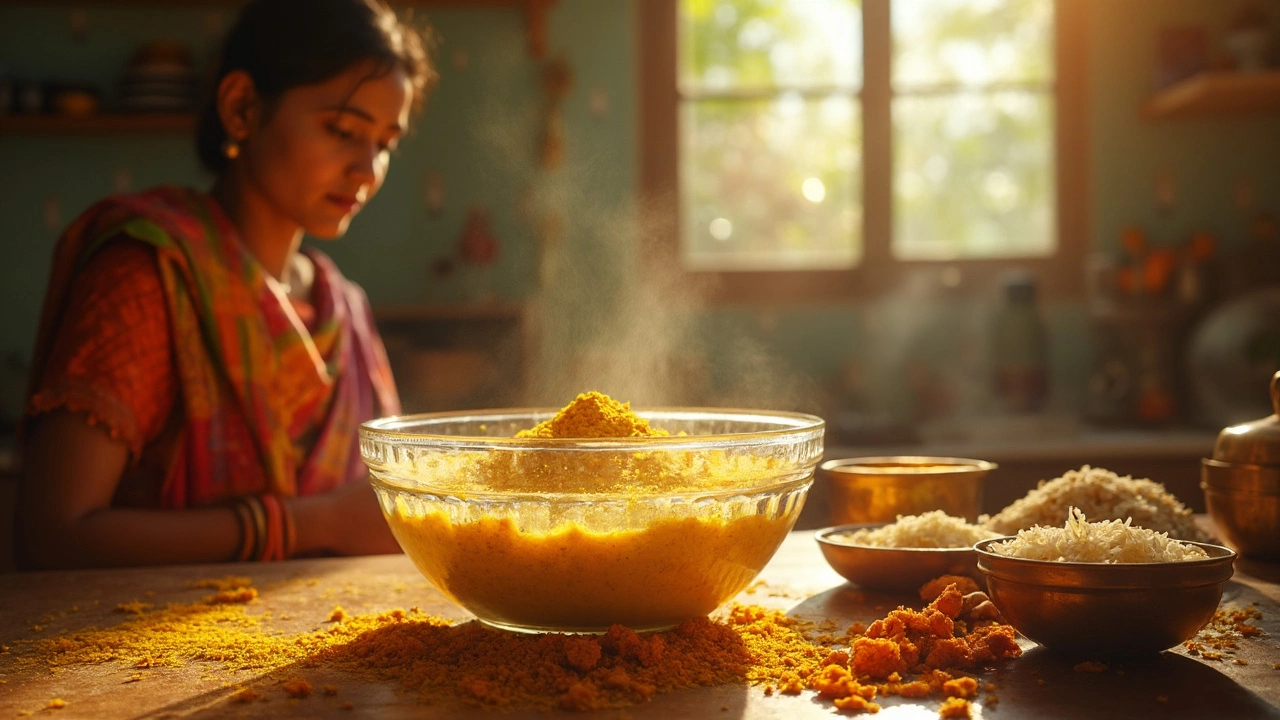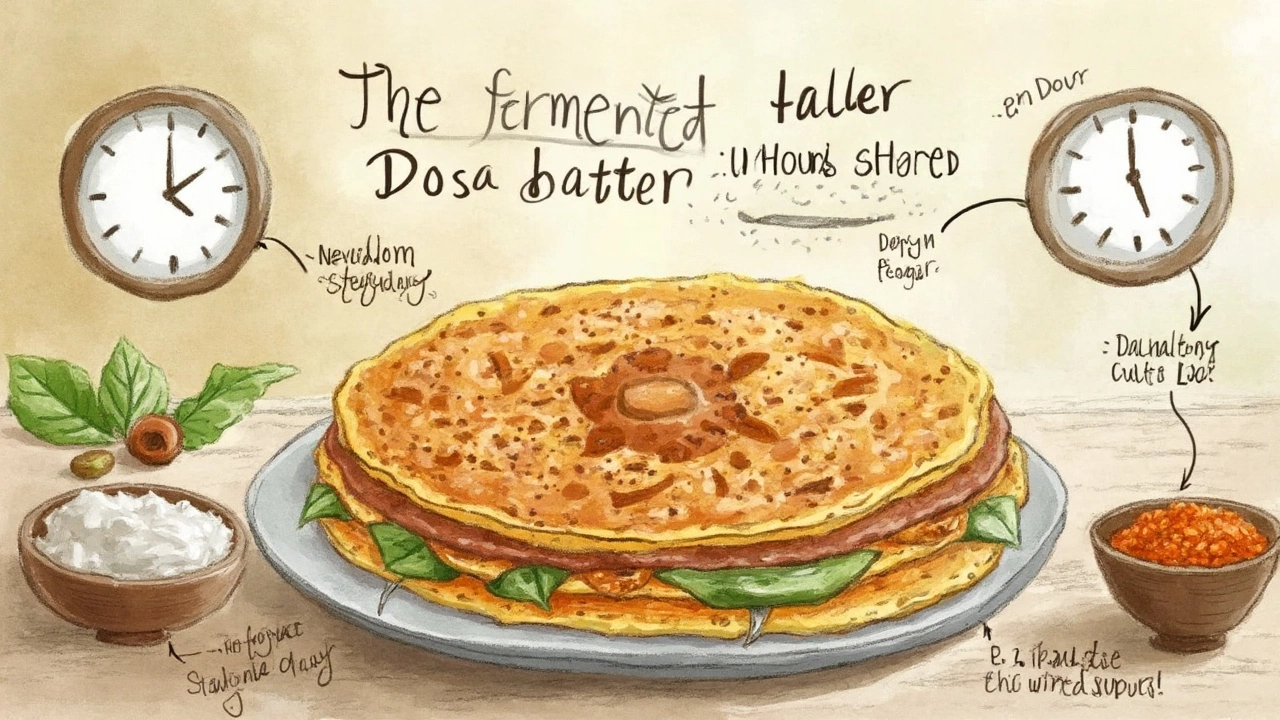Can Dosa Batter Ferment in 2 Hours? The Quick Fermentation Truth

Ever found yourself standing in the kitchen, glancing at the clock, and wondering if there's any hope your dosa batter will bubble up in just two hours? You're not the only one. Sometimes plans change, or you forget to soak rice and dal the night before (been there myself). But let’s get real—can you actually whip up well-fermented dosa batter in that short window?
This isn’t just about getting pancakes onto a plate fast. Fermentation means tangy flavor and that perfect airy texture we all crave. A short-cut attempt could leave you with flat, bland results. Still, there are times when you’re pressed for time and need breakfast or a dinner fix, like now.
So, what really goes on in that bowl during fermentation? Is there a way to speed things up without totally sacrificing taste or texture? Let’s break down the science, bust some myths, and see if there’s any magic to truly quick-ferment dosa batter.
- What Actually Happens During Fermentation
- Factors That Affect Fermentation Speed
- Tricks to Speed Up Dosa Batter Fermentation
- The Short Ferment: What to Expect in 2 Hours
- Myth-Busting: How Fast Is Too Fast?
What Actually Happens During Fermentation
When you're making dosa, fermentation isn’t just about waiting around for the batter to puff up. It’s the magic that turns plain ground rice and urad dal into the tangy, light, crispy dosa we all love. At its core, fermentation is a process where natural bacteria and wild yeast munch on the starches and sugars in your batter, breaking them down and creating new flavors.
Here’s what’s happening under the hood:
- Natural bacteria and yeast start multiplying once you grind and mix your rice and dal. Lactic acid bacteria (like Lactobacillus) are the main drivers, along with wild yeast caught from the air or already on your ingredients.
- They convert starches into acids and a bit of carbon dioxide (CO2). The acids add tang, and the CO2 helps puff the batter for a light, spongy texture.
- This process can also make the batter easier to digest by breaking down some of the complex carbs and proteins.
One classic study from the Indian Journal of Microbiology found that, over 8-16 hours, the acidity of dosa batter can double as lactic acid levels increase and pH drops from around 6.5 to 4.2. This level of sourness is what brings the authentic dosa flavor.
“Fermentation enhances the nutritional quality and digestibility of rice-lentil batters, producing characteristic flavor and texture unique to traditional dosas.” — Food Microbiology, 2021
Now, while people often toss the batter onto the counter and wait for some foaming action, you need time for these microbes to really get going. A slow rise is a sign the bacteria and yeast are having a field day. In just 2 hours, though, you’ll see barely a hint of this action because the microbiome is only starting to warm up.
This recipe isn’t just about patience—it’s science at work. For a quick look at how acidity changes as batter ferments, check out these numbers:
| Time (hours) | pH Level | CO2 Bubbles |
|---|---|---|
| 0 | 6.5 | None |
| 2 | 6.2 | Very few |
| 8 | 5.2 | Some |
| 12 | 4.5 | Lots |
So, when you’re thinking about dosa batter and quick fixes, remember what’s happening behind the scenes. It’s a living, bubbling process that needs time to truly develop those signature flavors and textures.
Factors That Affect Fermentation Speed
Fermenting dosa batter isn’t just about waiting around. Several things control how fast that mix of rice and dal gets bubbly and tangy. If you want to speed things up (or just stop your batter from turning into a science project), you’ll want to pay attention to these real-life details.
- Temperature: This is the big one. Warm weather or a cozy kitchen helps yeast and lactic acid bacteria go wild, making your batter rise and develop those classic flavors. In India, even night-time temperatures can be perfect for fermenting. But in places where it’s chilly, batter might just sit there, stubborn as ever. If your kitchen is below 25°C (about 77°F), fermentation really slows down.
- Ingredient quality: Fresh urad dal (split black gram) and good rice are a must. Old or poor-quality dal doesn’t always ferment nicely. Also, the type of rice matters—parboiled rice works better than basmati for most dosa batter recipes.
- Water: Don’t use hot water; lukewarm is best. Chlorine in tap water can mess things up, so if your batter isn’t rising, maybe try filtered water next time.
- Salt timing: Adding salt before fermentation can slow some activity. Many home cooks (including Priya) add salt after fermenting, especially in winter.
- Grinding method: Old-school wet grinders give you fluffier batter, which helps with air bubbles. Blenders work, but they tend to heat up the mix and can kill good bacteria if they get too hot.
Let’s see how these things actually stack up. Just to put the effect of temperature into perspective, here’s a quick breakdown:
| Temperature (°C) | Typical Fermentation Time |
|---|---|
| 15-20 | 12-20 hours |
| 21-25 | 8-12 hours |
| 26-30 | 6-8 hours |
| >30 | 4-6 hours |
If you're trying for quick dosa, every degree counts. Sometimes, folks place their batter inside a switched-off oven or near a warm appliance to push things along. The same batch that takes all night in a cool place can double up in just a few hours if it’s warm.
One last thing: too much water or too dense a batter can slow everything down. It should look like thick pancake batter so the bubbles have room to form. If you nail these factors, you’ll get better results—whether you’re rushing or have the patience to let your dosa batter hang out overnight.

Tricks to Speed Up Dosa Batter Fermentation
If you're hoping for quick dosa or just forgot to plan ahead, there are actually a few decent ways to give that dosa batter a boost. The classic method—just letting it sit out—takes time, but these hacks can help you get things moving faster.
- Warm Spot Magic: Batter loves warmth. If your kitchen’s chilly, stash your bowl in the oven with the light on. No heat, just the light. It’ll help create just enough heat that fermentation kicks up a notch. Some folks even put it near a running appliance, like on top of the fridge.
- Add a Pinch of Sugar: Yeast and bacteria gobble up sugar. Adding half a teaspoon of sugar to your fermentation stage can give the natural bacteria a head start. Don’t go overboard, or your dosa will taste off.
- Mix in Cooked Rice or Poha: Tossing in a couple of spoons of cooked rice or soaked poha (flattened rice) before grinding can make a big difference. These starchy ingredients provide food for the bacteria, helping things bubble up faster.
- Use a Starter: Save a little batter from a well-fermented batch as a ‘starter’ for your new one. It acts just like using sourdough starter for bread—speeds everything up.
- Instant Yeast: If you’re really pressed for time, some people cheat with a pinch of instant yeast. Use about 1/8 teaspoon per cup of batter. Cover and let it sit for an hour. You’ll get the rise, but the taste is a bit breadier, not the classic tang.
Check out how these hacks stack up for speed:
| Method | Average Time to Bubbles | Flavor Impact |
|---|---|---|
| Warm Spot Only | 4-5 hours | Traditional |
| Sugar Added | 3-4 hours | Slightly Sweeter |
| Starter Batter | 2-3 hours | Best Tang |
| Instant Yeast | 1-2 hours | Less Authentic |
One last tip: don’t cover your batter tightly. You want it loosely covered so air gets in but bugs stay out. And remember, if you get a good rise but not a super tangy taste, that's pretty normal for lightning-fast fermentation. Still better than waiting overnight when you’re hungry now.
The Short Ferment: What to Expect in 2 Hours
If you’re hoping your dosa batter will be magically fluffy and sour in just 2 hours, it’s time for some straight talk. Traditional dosa batter needs around 8 to 12 hours of fermentation for that signature taste and texture. But what really happens when you give it just 2?
First, the batter will probably show little to no visible rise. If it’s hot and humid (think over 30°C/86°F), you might see a few tiny bubbles and a mild looseness, but don’t expect the full lift. The lactic acid bacteria and wild yeast in the mix just don’t work that fast in average kitchen conditions. You’ll get a starter-level ferment—enough for the batter to lose a bit of its raw smell and maybe a hint of sourness, but nowhere near that tangy kick we all know.
If you used a shortcut like warm water, a preheated oven (with just the pilot light on), or even a pinch of commercial yeast, you might notice a touch more activity. Here’s what you can look for after a 2-hour ferment:
- Slight loosening of the batter, but not much rise or foam.
- Mild, almost unnoticeable, sour smell.
- Dosa made from this batter will be softer but less crisp and lack rounded flavor.
Some folks try to cheat with extra baking soda or curd. But adding too much will affect both taste and health: you get a weird aftertaste and the batter can turn rubbery. For authentic flavor, real fermentation is the secret sauce. On rushed mornings, though, here’s the honest rundown:
| Fermentation Time | Texture | Flavor | Appearance |
|---|---|---|---|
| 2 hours | Slightly soft, rarely airy | Almost bland, weak sourness | Lacks bubbles, little rise |
| 8-12 hours | Light, crisp edges | Noticeable tang | Lots of bubbles, visibly risen |
If you still need to serve up those dosas in a hurry, use smaller, thinner pancakes and cook them hot. They might not win any South Indian grandma’s approval, but they’ll definitely fill the gap for a meal. Just remember, true dosa batter greatness takes a bit of patience.

Myth-Busting: How Fast Is Too Fast?
Okay, time for some straight talk about dosa batter fermentation. It’s tempting to scroll through the internet and believe stories about ultra-fast dosas that are just as good as the classic version. But honestly, there are limits to how quickly you can get that real, tangy flavor and springy texture—and it all comes down to science.
Fermentation is a process run by natural bacteria and wild yeast in the rice and dal. These friendly microbes chow down on starches and sugars, creating little gas bubbles and mild acids. This not only helps your quick dosa rise but gives it that signature depth. In most home kitchens, proper fermentation takes 8 to 12 hours, especially if the weather’s cool. Even in hot, humid places like Chennai, you rarely get the right batter in less than 6 hours.
Here’s the kicker: If you try speeding things up with a warm oven or by adding extra yeast, you might get some bubbles, but you’ll often lose out on flavor. The batter may look aerated but taste bland, and the texture isn’t quite right. Plus, going too fast risks growing the wrong types of bacteria, which can mess with taste and even upset your stomach.
- A quick 2-hour ferment might work in a pinch if you use shortcuts (like a dash of yogurt or commercial yeast) but the classic, slightly sour flavor just won’t be there.
- Some folks try adding baking soda right before cooking for a fluffier result, but again—you’re shortcutting natural fermentation, not actually replacing it.
- If you must go fast, using very warm water and keeping your batter in the sun can help, but results will still fall short of the real deal.
Check this quick breakdown of fermentation times versus key results:
| Time (Hours) | Expected Texture | Flavor | Notes |
|---|---|---|---|
| 2 | Somewhat airy | Mild, a bit flat | May need added yeast/baking soda |
| 6-8 | Light and spongy | Mildly tangy | Better structure, more authentic |
| 12+ | Optimal airy, lacy | Classic sour flavor | Best for traditional dosa |
Here’s my honest verdict as a dosa fan: there’s no true substitute for slow, natural fermentation if you want that perfect dosa batter. Quick hacks might work for a weeknight emergency, but if you’ve got the time, let it rest. Your taste buds will thank you—and so will anyone eating at your table.